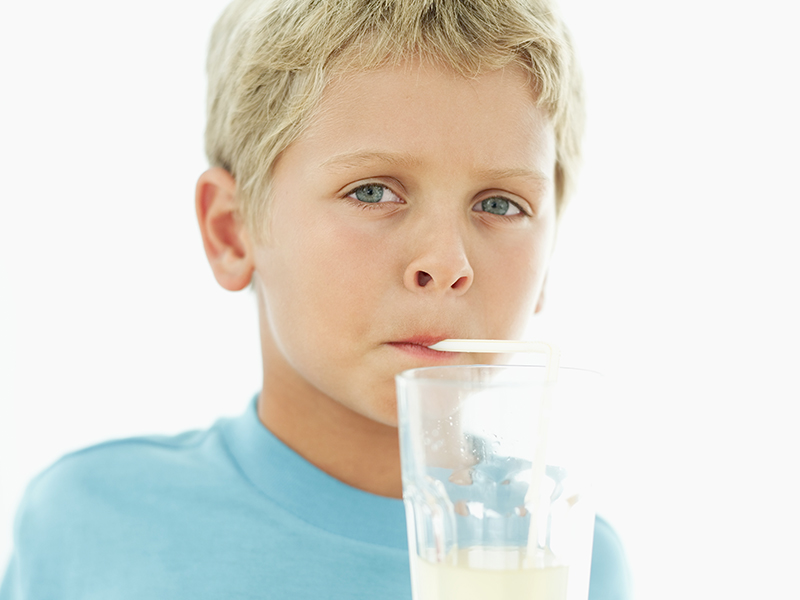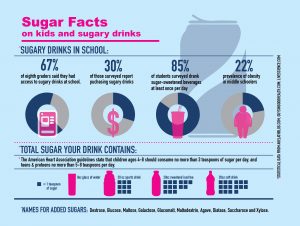The Unsweet Consequences of Sugary Drinks on Kids
More than one-third of children and adolescents were overweight or obese in 2012, according to the Centers for Disease Control and Prevention, and a Tufts University study published in June points at least one finger directly at sugary drinks. According to the study, 1 in10 obesity- and diabetes-related deaths of those younger than 45 in the United States are attributable to sugar-sweetened beverages.
“That’s a huge number of deaths from just one source,” says Dr. Alison Scott, assistant professor of kinesiology and health sciences at the College of William & Mary. SSBs—the health industry’s shorthand for sugar-sweetened beverages—are “ubiquitous in kids’ worlds,” “marketed to them like crazy,” and “designed to maximize enjoyment,” Scott, a mother of twin 6-year-olds, says. “It’s the path of least resistance to go along with that flow. Unfortunately, it’s a ‘flow’ that’s killing our kids.”
In addition to SSBs, Dr. Amy Lazev, supervisor of the Williamsburg-James City County Schools’ School Health Initiative Program (SHIP), cites decreased physical activity and increased “screen time” as a cause for the rise in childhood obesity and diabetes, which the CDC calls “one of the most common chronic diseases among children in the United States.”
According to data collected by Rev Your Bev, a statewide, event-based initiative that raises awareness about sugary drinks, 33 percent of those ages 5 to 19 years old drink at least one SSB each day, corresponding nicely with CDC’s one-third figure and begging the question: Is sugar making our kids fat?
A Sweet Convenience
“We live in an environment where sugary drinks and foods are everywhere,” says Scott. “You’re bombarded with them at the grocery store, in restaurants, at extracurricular activities and sporting events, at gas stations and often even at school.”
We all know there are few places that are absent the temptation of sugar (we’re talking about you, Best Buy checkout). Worse, sugary drinks are as convenient in price as they are in accessibility, Scott says, pointing out that soda is cheaper than milk. “In a culture where families are busy, stressed, and often struggling to make ends meet, these things matter,” she says. Scott blames generous government subsidies for corn and soy production as one reason processed foods and drinks are so inexpensive. “Paradoxically, taxpayers have helped fund the production of the products now threatening our kids,” she says.
Sugary Substitutes
“Sugar isn’t just called ‘sugar’ on food labels,” Scott says. “I’ve spent many an unpleasant hour squinting at labels in the grocery store. Even if we all had PhDs in biochemistry and could identify all the compounds and their relative badness, who the heck has time for that?”
Lazev says she has noticed SHIP students cutting down on sodas. The problem, though, is what she calls a “significant” increase in the consumption of other sugary drinks, like sports and fruit drinks. “I believe that many parents are not aware of just how much sugar is in sports drinks,” she says. Scott, who points to coffee and energy drinks as additional culprits, says switching kids from Coke to Gatorade isn’t helpful. Sugar, she says, “comes in many different forms with different properties.”
The School’s Role
Lazev says schools have an obligation to teach students about health and nutrition as part of Virginia’s Standards of Learning. “I believe that teaching students about health and nutrition happens not only in the classroom, but also in the cafeteria,” she says. “By providing healthy choices, students have the opportunity to directly apply what they have learned.”
The concern, despite such knowledge, is what students will pick when given the choice between a salad and a cheeseburger. Scott points out the public’s sensitivity to the “policing” of personal choice. “Schools and governments can’t tell people what to eat,” she says, “but they can support the creation of environments for kids, in schools and communities, where healthy choices are provided and supported.”
Another issue at schools, Scott says, is budget-related. In the past, schools have entered into exclusive contracts with beverage companies—sometimes called “pouring rights”—in exchange for desperately needed funds. “That’s an indictment of our society at large, in my opinion, that schools are so poorly supported that they need to resort to these strategies,” Scott says. “Yes…Pepsi will sell well in the lunchroom, which will help keep operations funded, but at what cost?”
Looking Ahead
Effective August 27, 2013, federal regulations imposed stricter limitations on beverages offered at schools participating in the National School Lunch Program and School Breakfast Program. The regulations limit elementary and middle school students to water, milk, fruit juice and vegetable juice, and allow high school students caffeinated options with calorie restrictions.
Scott realizes the balance between individual rights and community well-being is “sticky” but says the problem must ultimately be solved on a community level, not an individual one. “You can purge your kitchen of sugary beverages and foods, but that only goes so far,” she says. “Kids live in communities, so we have to address these things as a community, both locally and nationally.”


